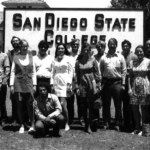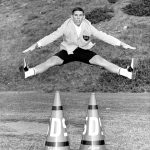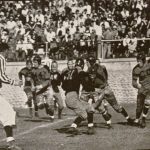
As the oldest higher education institution in San Diego, San Diego State University is celebrating 125 years of educating the community this year.
The founding of the school dates back to 1897. That is when the San Diego Normal School was in a building in Downtown San Diego.
Move forward nearly 25 years and San Diego Normal School would transition to San Diego State Teachers College. The school would relocate a decade later to its current location on Montezuma Mesa. In 1935, San Diego State Teachers College would take on a new name; San Diego State College. The school would become known as San Diego State University in 1974.
SDSU history curator and anthropology professor, Seth Mallios, noted the school is honoring the anniversary in a number of ways.
They include: 2022 birthday celebration which (was in March); fall 2022 homecoming (slated for early November); commencement ceremonies on (March of 2023); and a re-enactment of the first day of school on (Nov. 1, 2023).
According to Mallios (at the school 21 years), SDSU will graduate its 500,000th student this year during commencement.
The anniversary is also important to many SDSU alumni.
Jim Herrick, SDSU’s alumni association executive director, noted all alumni are not actual graduates, as the school also counts those who attended. “But, yes, at commencement this May we will officially surpass the half-a-million mark. This puts us in elite company with only a handful of U.S. universities having more than 500,000 alumni,” Herrick stated. Among the notables to attend SDSU commencement ceremonies over the years was JFK (pictured above on campus in 1963).
“I can tell you as the university history curator, every week I am contacted by someone who has a story, an artifact, or memory to share,” Mallios commented. “For example, I was emailed by a relative of a former SDSU employee asking for a 125th anniversary pin so that he could place it in the dirt above his father-in-law’s Fort Rosecrans grave. He knew that SDSU meant that much to his father-in-law.”
Among some famous students to attend SDSU are Tony Gwynn, Gregory Peck, Raquel Welch, Carl Weathers, Marshall Faulk, Kawhi Leonard, Art Linkletter, and Marion Ross.
SDSU has played a huge role in the community since its founding.
Mallios noted, “There are many ways to measure impact and I could go on at length about it. Even back in the 1940s, it was clear to many civic leaders the importance of San Diego State. Economically, the current impact can be measured in dollars. San Diego State University has a $5.67 billion annual impact on our region. The university supports some 42,000 jobs that generate $2.01 billion in salaries and wages. In addition to the $5.67 billion in industry activity, SDSU produces $457 million annually in state and local taxes.”
“More than 2,000 folks attended our March 14th events, celebrating our signing of the charter/birthday on campus,” Herrick commented. “Our SDSU alumni board members were out in force all day talking up SDSU.” Alumni and friends have been awestruck by SDSU history and its portrayal in Mallios’ exhibits and vignettes.
La Mesa resident Jim Newland arrived at SDSU in September of 1985 as a junior transfer with a geography major. He would go on to earn a B.A. in social sciences (1988) and M.A. in public history (1992).
“Subsequently, I have been a practicing professional historian working as a historic resources consultant, museum curator, land use planner, historic preservation specialist, and educator the last 26 years with the California State Parks Department,” Newland said. “Considering that I didn’t even know that the profession I’ve been practicing for the last 30 years existed prior to my time at SDSU, there is no doubt that my life would have followed a far different path without attending. This is also not mentioning that I met my future wife, Jennifer Jones, at SDSU. Jennifer also has a great connection to SDSU, receiving her Master’s in public health and working over 30 years for the SDSU Foundation as an epidemiologist.”
When first arriving at SDSU, Newland noted the campus had far more students than space.
“It was a struggle for many to get classes or find nearby housing,” Newland stated. “My wife and I purchased a home in nearby Rolando in 1994, where we lived for 10 years. Here I began the college neighborhoods history project, focusing on the significant role that the campus’ move to its current location in 1931 had on converting these undeveloped, rural lands into the suburban neighborhoods surrounding the campus today. After moving to La Mesa in 2004, I continued to pursue and support efforts to expand the campus and improve its relationship with the local communities including the campus expansion into Mission Valley.”
For Newland, he feels strongly that attending and graduating from SDSU “has had a profound, meaningful and guiding direction in any possible achievements in professional and personal elements of my life.”
Not only has SDSU had a positive impact on his life and that of his wife, he feels strongly that the school has touched the lives of many others.
“Having lived or worked in or nearby La Mesa since my arrival here to attend SDSU in 1985, and my decades in studying the history of the school and the local communities, and serving on both the City’s planning and historic preservation commissions, there is no doubt that the success of SDSU is a key element in the social, economic and cultural aspects of the greater La Mesa area,” Newland remarked.
Another La Mesa resident with ties to the school is associate professor of anthropology Isaac Ullah.
The sixth-year professor hails from Northern California and spent a lot of time in San Diego over the years.
“When I saw that SDSU had a tenure-track position within my specialty (archaeology), I jumped at the chance,” Ullah remarked. “Luckily, my application and interview went well, and I got the job. SDSU is a great place to work, and I arrived at a really interesting time in the sense that SDSU is really pushing right now to emerge as a new kind of public university.”
Having settled in La Mesa not too long ago, Ullah said SDSU is “our” school.
“Beyond the typical things, such as being the focus of local college sports fans, university branding being seen around town, and a wide set of local alumni, you can see the impact of SDSU in a lot of less obvious ways around town,” Ullah commented. “I know several SDSU faculty and staff serve in various volunteer positions either with the city (for example, I was a commissioner with the La Mesa Historic Preservation Commission), or with local grassroots or community services (the historical society, various arts projects, the SDSU Sage project, etc.).”
When asked what it has been like to work on the 125t anniversary, Ullah noted all the work of departmental colleague Mallios. “Seth’s role as the university history curator, and his ongoing research in the field of historical archaeology in the San Diego region has positioned him as the foremost expert on campus history and archaeology,” Ullah stated.
Ullah went on to say that with an interest in local history, he has been partnering with the La Mesa Historical Society and the City of La Mesa to lead an internship program where SDSU students document potentially historical structures across the city in an attempt to help update the city’s inventory of historical buildings.
“I also lead a project to help collect and curate digital imagery related to the events of May 2020, which hit especially close to home for me, as I live right in the Village,” Ullah stated. “I also have an MA student, Sarah Benchekroun, who has been focusing on 3D scanning some of the historic infrastructure in Collier Park (especially the Spring House and the water fountain) as part of her thesis research. Those are really La Mesa history projects, however, but I do see them as contributing to the longer-term history of SDSU’s presence in our local communities.”
Safe to say, many people appreciate all the school has given them over its 125 years.
(Photos courtesy of San Diego State Special Collections and University Archives)
– Reach editor Dave Thomas at [email protected].














